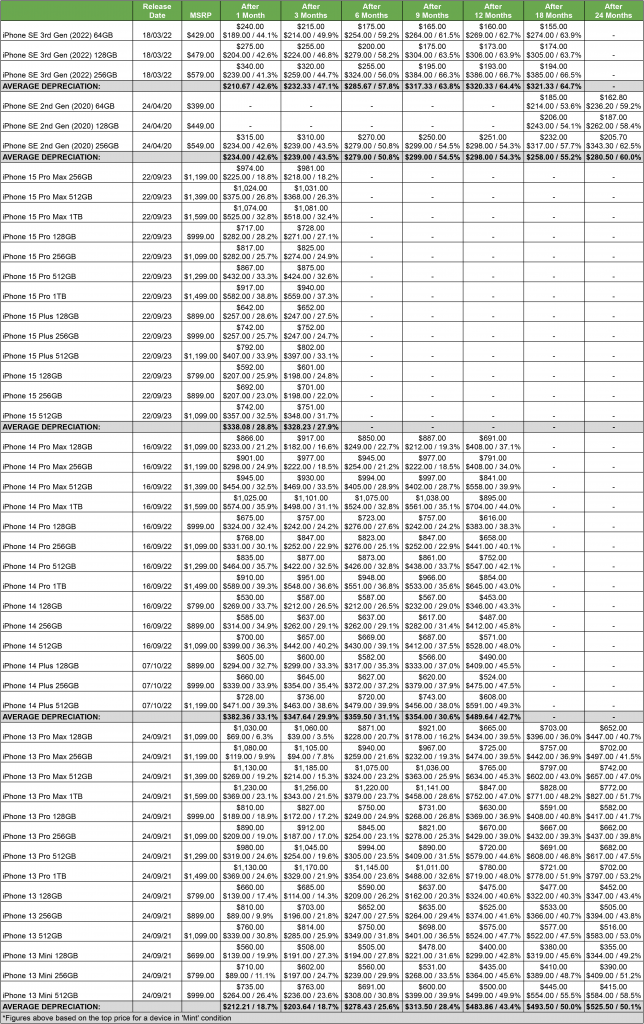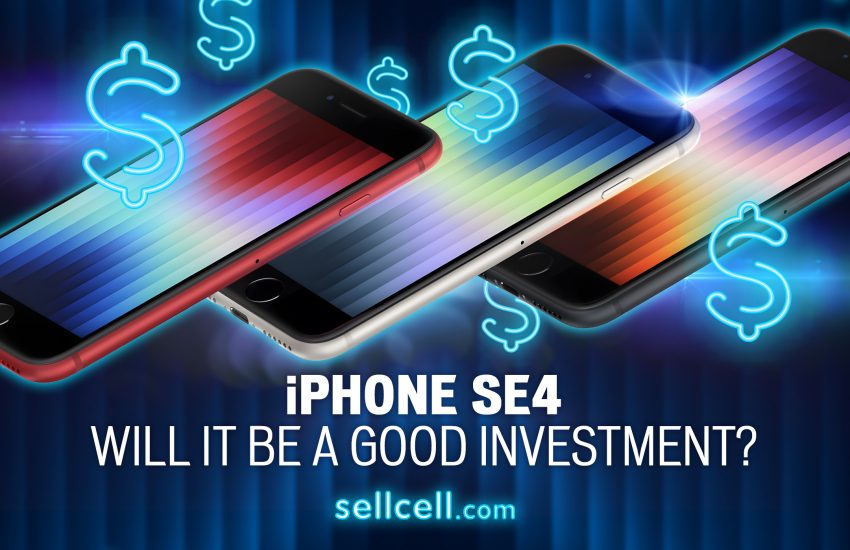The iPhone SE 3 range lost up to 65% after the first 18 months post launch—could the iPhone SE 4 be a non-starter?
– The SE 3 lost 42.6% of its value one month after launch. After 18 months, depreciation had reached 64.7%.
– The SE 2 also depreciated by 42.6% of its value after one month. After 24 months, average depreciation was 60.0%.
– The iPhone 14 base range lost, on average, 45.7% value over 12 months, 18.7% less than the SE 3 range in the same timeframe.
The iPhone rumour mill is, once again, in full swing, with the iPhone SE 4 the subject of much gossip. Now we have the latest iPhone 15 range in stores, attention turns to Apple’s entry-level smartphone, the iPhone SE. Pretty much everyone is discussing what potential features the device could have. Another point of conjecture is when the next iPhone SE model will launch. It should be 2024, but some say it might not be in consumers’ hands until 2025.
But is there any point in waiting for the iPhone SE 4? Will it be an excellent investment or could it be a better idea to move across to another iPhone model? When looking at what makes a phone successful, resale value is a good marker to determine if a phone is a sturdy investment. Resale value is what a phone owner will make if they sell their phone on, or trade it in the future, and how much the device has depreciated since launch.
Looking back at historical resale data of the iPhone SE 2 & 3, SellCell can forecast how the iPhone SE 4’s resale value may track and how much it is likely to lose post launch. This may help buyers to determine if it is a worthy investment, and if it will still retain value at resale/upgrade. We can also compare the iPhone SE value data to other iPhone ranges to compare how they hold value against the iPhone SE ranges. Let’s look at the data…
Key Highlights
- On average, the iPhone SE 3 lost 23.9% more than the iPhone 13 range did in one month post launch. After three months, this figure was at 28.4% more depreciation.
- Compared with the iPhone 14 series, the SE3 lost 9.5% more value in one month, and after three months it had lost 17.2% more than the iPhone 14.
- The iPhone 15 is performing well compared to the SE 3. It has depreciated 13.8% less than the SE 3. After three months, the difference is 19.2%, with the SE 3 trailing far behind the iPhone 15 in depreciation terms.
- The iPhone SE 3 launched in March 2022, priced $429-$579. After one month, the whole SE3 range had lost 42.6% of its value. After three months, it had lost 47.1% and, heading to 18 months, depreciation was 64.7%.
- By comparison, the iPhone SE2 range lost the same as the SE 3 range in month one; 42.6% ($234). After three months, depreciation was 43.5%. After 24 months, depreciation was 60.0%.
- Of all iPhones released since 2021, the iPhone 13 performs best. It only lost 18.7% of its value in month one, across the range. After 3 months, it had lost no further value. After six months, it had depreciated by only 25.6%.
- The 2023 iPhone 15 range is also doing really well for value retention. Every model has actually regained some lost value after three months. The average depreciation across the range sitting at 27.9%, where it was 28.8% after one month.
- Historically, flagship iPhone models have performed better for value retention than the budget-friendly SE models.
Summary

Did the iPhone SE Ranges Hold Value Vs Other iPhone Models?
As the above table illustrates, the iPhone SE ranges have, historically, not performed all that well for value retention. The most recent iPhone SE—the SE 3 series, released in March 2022—lost 42.6% of its value across the range, in the first month post launch. By three months, this was down to 47.1%. At 18 months, depreciation was at 64.7%.
By contrast, the 2021 iPhone 13 lost only 18.7% of its value in the first month. We can see demand hadn’t dropped three months later; the iPhone 13 range value was the same! Fast forward to 18 months post-launch and the 13-series has still only lost 50% of its value. By 24 months, value has only dropped by a further 0.1%. So, by comparison, the SE 3 range depreciated 23.9% more than the iPhone 13 range in one month, and 28.4% after three months.
While the iPhone 14 doesn’t depreciate as much as the iPhone SE3, it lost 33.1% of its MSRP in its first month, across the range. However, this series actually regained some of its lost value after three months. Depreciation dropped to 29.9%. After 12 months, the range has lost 42.7% of its value, seeing a sudden depreciation between the end of months nine (30.6%) and 12. On average, the iPhone 14 depreciated 9.5% quicker after one month, and 17.2% after three months.
After one month, we saw 28.8% value loss for the iPhone 15. After three months, depreciation is 27.9%. Compared to the iPhone SE 3, the iPhone 15 series lost its value 13.8% slower in month one, and 19.2% slower after three months.
So… what does all this mean for the iPhone SE 4?
Is the iPhone SE 4 Likely to Be a Solid Investment?
If we are to look at resale value only, the iPhone SE 3 range depreciated 17.2% more than the iPhone 14 range after 3 months, and 19.2% more than the iPhone 15 range after 3 months. So, users may decide—if they want a phone that will be worth more when they trade in—they should move up the range and invest in a more premium model, rather than opting for the budget handset.
Some may say that a budget phone will always depreciate faster than a flagship phone, but this hasn’t always been the case. Indeed, prior to its discontinuation the iPhone 13 mini 128GB depreciated by only 42.8% 12 months post-launch, which is 11.5% less than the iPhone SE 2 and 21.6% less than the iPhone SE 3. This shows a budget phone can be a winner in holding its value.
There is also an argument that as Apple has discontinued the Mini, and the SE 4 is still not available, there may be an increased demand for a budget iPhone and, as such, this may push up resale values for a new SE. In such an event, the SE 4 could well be worth the wait.
As always, if you plan to sell an iPhone (or any phone, for that matter), SellCell advises you keep on top of your phone’s resale value so get the most value for money, making your next purchase—iPhone SE 4 or not—an even sounder investment. SellCell has a handy trade-in price alert you can subscribe to, to help stay abreast of your phone’s depreciation and make the best decision on when to sell.
When Will the iPhone SE4 Launch and Will it Have a New Design?
Previous release trends show that Apple has launched the iPhone SE range upgrade every two years. With this in mind, we should see an iPhone SE 4 very soon, providing Apple intends to release the device. The most recent reports have suggested that the new phone is likely to be in 2025, with some cool new designs that mirror the iPhone 14 with an OLED panel and more, as GSM Arena’s report on the SE 4’s appearance states. MacRumors’ iPhone SE 4 article asserts we could see the new SE 4 handset in 2025..
Will the iPhone SE 4 Prove a Success?
One has to hope that, by now, Apple knows its customers are looking for improvement on previous models. The SE 4 would struggle not to improve on the now-dated SE 3, so Apple fans looking for a budget purchase that is up to modern standards are likely to look towards an SE 4 model, if Apple ever releases one, of course. Will it be a success?
That remains for us to see. To be a win for ‘upgraders’ wanting to get the best bang for their buck when they sell, the iPhone SE 4 needs to hold out on more value and depreciate in line with the iPhone mainstream ranges, like the iPhone 15 for example. But, let’s be honest, resale value aside, none of Apple’s smartphones could really be described as an abject failure, could they?
Methodology
SellCell collected current and historical value data for the iPhone SE 3, SE2, 15, 14, and 13 models. It analysed this data in order to identify trends relating to value depreciation, and suggest whether the iPhone SE 4 will perform well in this respect.
Our content is created in good faith and reviewed regularly - if you spot an error, please contact corrections@sellcell.com. Read our Editorial Policy
